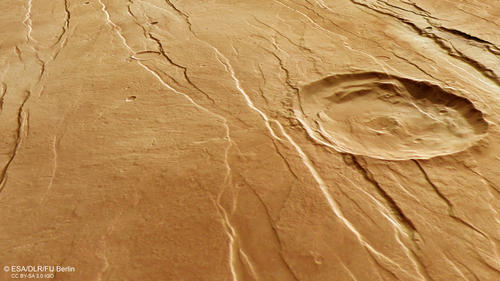Tantalus Fossae - Tantalizing Tectonics
The Tantalus Fossae are a set of giant faults and fractures, located on the eastern side of Alba Patera in the Arcadia quadrangle. These faults are referred as grabens and the result of extensional forces associated with the uplift of the Alba Patera volcano. When the extension of the crust creates two parallel faults, the rock in between the faults drops down into the void created by the extension and forms a graben. The same features can also be found on the western side of Alba Patera, forming an incomplete ring around the volcano. Alba’s graben structures are up to 1000 km long and have a width of 2-10 km with depth ranging from 100 to 350 m.
Throughout the image we can spot numerous graben structures running roughly from the northeast to the southwest. These structures were not all created at the same time, but one after the other. This gives geologists the opportunity to reconstruct the events that created this astonishing landscape. The large impact crater in the image center for example is crosscut by some grabens which means, that it was already present before the volcano was uplifted what in consequence created the faults. The second largest, filled impact crater and many smaller ones, appear to superpose the faults and are therefore younger.
At closer look, a large network of small dendritic valleys can be found all over this HRSC observation. The valleys appear to be older than the graben structures because they were not deviated by the faults and appear to directly cut through them. This area is located on the flanks of the Alba Patera volcano and the northern (right) part of the image is located much deeper than the southern side. This can well be seen on the color-coded elevation model. Thus, these valleys should run along the slopes and merge in the deepest area. This can’t be observed at this location. The valleys must therefore originate from more ancient times.
The area is named after Tantalus, a son of Zeus and Pluto who, according to the legend, betrayed the gods and was sent to Hades where he was forced to stand in water underneath a fruit tree. When he tried to drink, the water retreated and when he tried to eat, the branches moved out of his reach. This punishment is known today as the torments of Tantalus.
